#Krauss-Maffei
Explore tagged Tumblr posts
Text
Kolej na sztukę (2)

Dziś prezentujemy bardzo atrakcyjny obraz.
Obraz jest prezentowany w budynku administracyjnym firmy Krauss-Maffei. Dzieło C. Heringa z 1916 roku przedstawia transport fabrycznie nowego parowozu za pomocą 27-konnego zaprzęgu. W ten sposób przewożono parowozy przez Monachium do najbliższej bocznicy kolejowej. Elementem fikcji artystycznej jest jedynie nazwa kolei państwowej B IX "Donaustauf", poprawnie brzmiącej B IX "Donnersberg".

opracowanie: Norbert Tkaczyk na podstawie B. Ücker "150 Jahre Eisenbahn in Bayern". Read the full article
#Donaustauf#Donnersberg#historiakolei#kolejnasztukę#Krauss-Maffei#Niemcy#obraz#ostatniafabrykaparowozów#parowóz
0 notes
Text
New Toys!
During the last few weeks a couple of new items were added to the rolling stock roster of my model railway. As per usual I had totally forgotten having “pre-ordered” them over a year ago. Model train manufacturers tend to announce new future projects with an option for the customer to “pre-order”. This pre-ordering process gives the manufacturers a rough idea on how many model train enthusiasts…
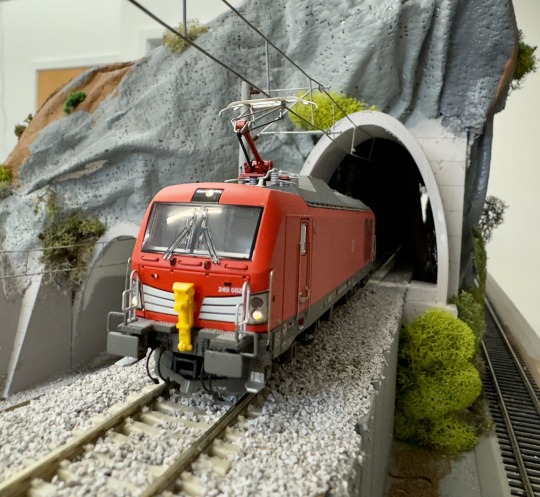
View On WordPress
#Denver and Rio Grande Western Railroad#Deutsche Bahn Baureihe 2149#Deutsche Bahn Baureihe 2159#diesel-hydraulic locomotives#EuroDual#German Rail Class 2149#German Rail Class 2159#Krauss-Maffei#Last Mile#ML-4000#Model Train Decoders#PIKO#Southern Pacific#Stadler#SudExpress#TRIX
0 notes
Text

Leopard column
14 notes
·
View notes
Video
India Railways - Class YP 4-6-2 steam locomotive Nr. 2259 (Krauss Maffei, München 18079 / 1954) by Historical Railway Images Via Flickr: Official Krauss Maffei (Munich, Allach Works) photo of a new Class YP 4-6-2 locomotive for service on India's meter-gauge railway system. Fifty such locomotives were built in Germany for the Indian Railways and delivered in February 1955 (KM 17991 - 18140). Their Indian Government Railways road numbers were 2171-2320. In total, 200 YP locomotives were ordered from KM up to 1954
#train#steam#locomotive#India#Railways#KM#Eisenbahn#Dampflok#Krauss Maffei#YP#1955#München#flickr#trainspam
4 notes
·
View notes
Text

Krauss-Maffei's Wildcat twin 30 mm cannon (MK-30-F) air defence system. The turret could fit a variety of vehicle from the Bradley to this MOWAG Shark 8x8.
28 notes
·
View notes
Note


Leo 2 of some sort.
Leopard 2a6, German MBT, Krauss-Maffei
Oh my poor girl... what have they done to you.
This is a captured Leopard, rigged with T-80 road wheels for transit.
10 notes
·
View notes
Text





Nr.280, The sdkfz 7 German heavy tractor.
The Sd.Kfz.7, or Mittlerer Zugkraftwagen 8t (Medium Tractor 8 tonnes), was developed as part of the larger family of German half-tracks. The first specifications for this vehicle were laid down in 1932 by Wa.Prüf.6. The vehicle was developed by Krauss-Maffei, with the first vehicle entering production in 1933.
As the designation suggests, the Sd.Kfz.7 was meant to tow weights of up to 8 tonnes. It was the tow vehicle of choice for the famous Flak 88 anti-aircraft guns, the 15 cm sFH 18 howitzer, and the 10.5 cm K18 field gun. However, due to the chaos of war, these vehicles were sometimes seen towing larger loads.
They also towed trucks and even light tanks through the harsh conditions on the Eastern Front. The Sd.Kfz.7 could also carry up to 18 men on its 3 benches. The rear of the vehicle was compartmentalized in order to carry various equipment, fuel and ammo.
This kit is a frankenstein project and made out of 2 incomplete kits.
29 notes
·
View notes
Text
GE PowerHaul
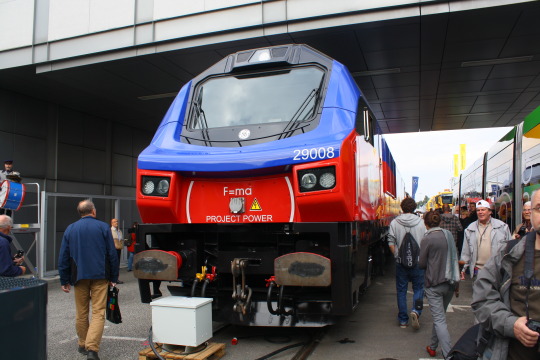
After I offered, @valtionrautatiet-official asked me to post some pictures of the locomotive that is nowadays known as the Dr20, used by the private freight operator North Rail in Finland. Here it is in 2012, long before anyone ever even considered sending it to Finland, in Berlin. The reason that it's in Berlin specifically is that it's at Innotrans, the biggest trade fair and exhibition for railroads that exists. At this point it had the paint job of HHPI (Heavy Haul Power International, despite the important sounding name really just one of many European freight rail companies with headquarters in Germany), with their trademark blue and red and their company policy of putting Newton's second law on it. "Project Power" also sounds cool, doesn't it? Well, it turns out they never entered service for HHPI. Way too much history under the cut.
The story behind these eight locomotives is weird and opaque, and there is a lot of stuff we may never know, but on a very fundamental level it seems to be one of the victims of what I call the six-axle diesel curse. This basic of that theory of mine is that it's impossible to sell big, heavy, powerful diesel locomotives, the kind that are so powerful that they need six axles for all the weight from their big engine and diesel tank, in (West) Germany and to a certain extent central and Western Europe, at least nowadays, unless you do it by accident.
The German locomotive industry has wanted to build big six-axle diesel locomotives since the end of steam traction. There was a prototype six-axle version of the V 200, named V 300, in the 1950s, but DB didn't want it (a related but less powerful version was sold to Yugoslavia to haul Tito's private train). For the Americans here, the Krauss-Maffei locomotives of the Southern Pacific and Rio Grande were related to that.
A few years later, in 1962, we get the V 320, a six-axle version of the V 160 locomotive family. The four-axle version was very popular and is still in service, but they only built the prototype of the six-axle version. Interestingly, that one prototype is still around as well, hauling construction trains. Deutsche Bahn was never interested, they preferred the flexibility of having more smaller units. And anyway, they were busy electrifying the busy main lines that would have made the most use of those heavy machines.
In the 1970s Henschel and BBC (the electric equipment one, not the British TV one) built three copies of the DE 2500 both with four and six axles, but those were really more experimental machines.
In the late 1980s and early 1990s, MaK tried to sell their DE 1024, and I actually have a picture of that ne.
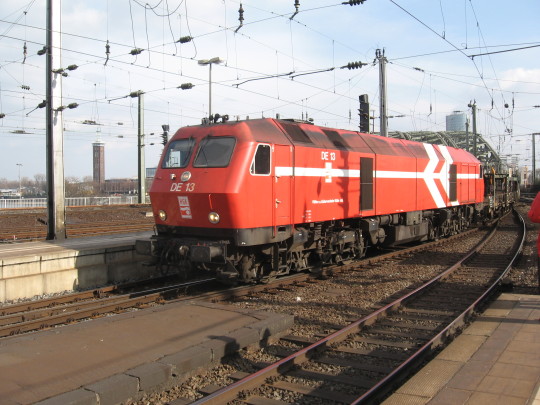
They built three prototypes, and Deutsche Bahn seemed to genuinely toy with the idea… but in the end it was decided to electrify the lines in the (mostly flat) north that hadn't been electrified yet anyway.
And at the same time, the wall fell, and suddenly Germany had access to all the locomotives of the east, now mostly surplus since mostly the industry they served did not survive the transition to western markets. East Germany had bought powerful six-axle diesel locomotives in enormous numbers from the Soviet Union, specifically modern-day Ukraine, and those were available, good enough and already paid for. In particular the class 232 and related, known as "Ludmilla" among rail fans, have proven very useful.
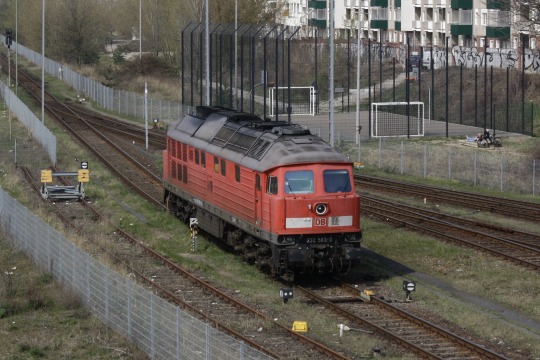
MaK was able to sell an altered version of that locomotive to Norway, but that turned out to be be a huge disaster as they developed a habit of catching on fire. Eventually Siemens (who briefly owned MaK) had to take them back, and since then they've changed hands an astonishing number of times - apparently right now Hector Rail and RDC Autozug have a lot of them. Here's one in Hamburg Altona when it was used on regional trains there.
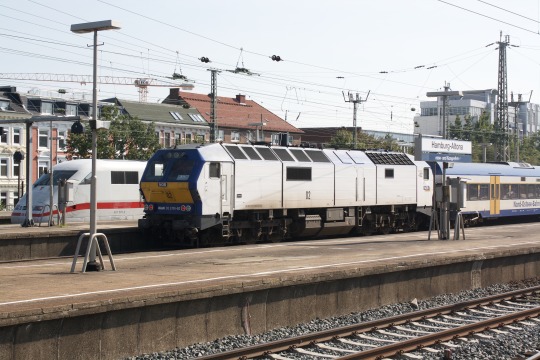
The three prototypes went to locally owned operator HGK, where two of them also burned down. DB probably dodged a bullet there. Interestingly enough, the only one that didn't burn down was number 13, but that was finally scrapped a few years ago.
In the mid-1990s, ADtranz (later Bombardier) and GE got together to build the Blue Tiger locomotive, a very distinctive-looking and noisy machine. They sold 11 to various private operators in Germany, 30 to Pakistan and 20 to Malaysia. Not terrible, but not a huge success either.
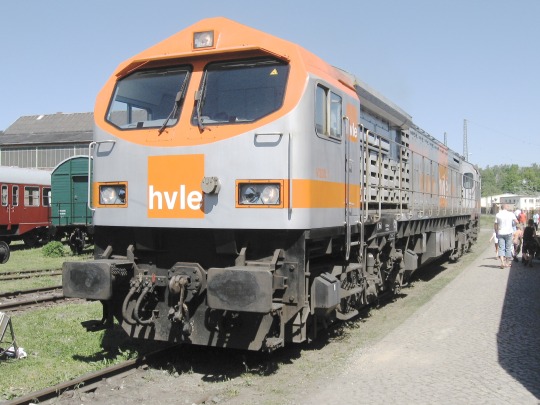
But in the 2000s, things were changing. Liberalisation meant that more and more companies were running services all throughout Europe. The busy main lines were electrified, but many of the border crossings weren't yet, so there was a new need for big six-axle diesel locomotives.
The big beneficiary of this was EMD from North America, who were already supplying such locomotives to Great Britain. The rail companies there needed these machines to replace unreliable British-built power, and to replace environmentally friendly electric locomotives, because most of the British network is not electrified and the few sections that are have way too much traffic on them.
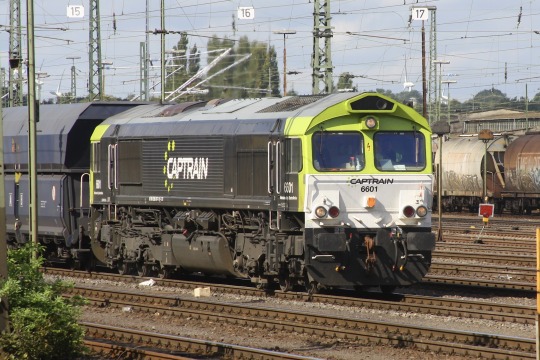
The Class 66 is an ugly mess, designed by figuratively building a metal shed in the inside of a tiny British rail tunnel. It's so noisy that drivers in Norway get hazard pay for being in them. But it works and it was mass produced, and a lot of them made their way to the continent in short order.
Other companies wanted in on that business. Voith decided to enter locomotive building after previously supplying traction equipment. They had high hopes for their Maxima series of locomotives, which they started building in 2008, and they had their own leasing company. They did a lot of marketing and the machine won prestigious design awards.
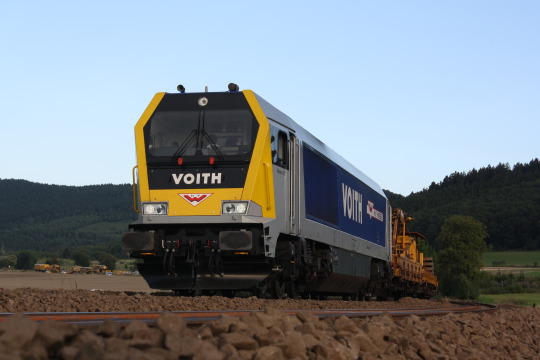
At one point they had a hundred pre-orders. In the end their own leasing company folded, and they only built twenty, which they didn't even manage to sell that quickly. Nowadays they've stopped producing locomotives again.
General Electric, the other North American locomotive company, wanted in on that action as well. Sure, it hadn't worked with the Blue Tiger, but years had passed and things were different now. For their new product, the PowerHaul, they decided to follow what EMD had done. They started with the class 77 for the British market, first shown at Innotrans in 2010.
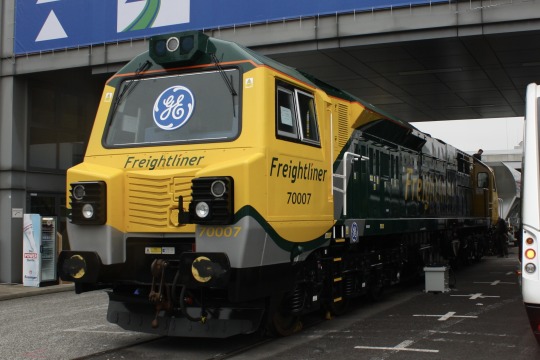
Then they wanted to work their way out to wider Europe, with a special continental version that was designed with a bigger shell to match the larger tunnels on the continent. That way they weren't quite as cramped. EMD had considered a similar idea, a European-sized class 66, but decided against that.
GE also did not intend to make them themselves. Instead after the initial batch of British 77s, they transferred production to their Turkish partner Tülomsaş, who supplied some more British ones and the ones for central Europe. 29008 is one of them.
In the end all of these plans fell through. A lot of the international border crossings did get electrified much quicker than the diesel sellers had hoped. The one near where I live, the Montzenroute, started electric running in December of 2008, and it was actually the makers of electric locomotives who made bank off of the new international railway world. Here is a Bombardier TRAXX electric locomotive during the first week that freight trains from Germany to Belgium were running with electric power, just a few hundred meters from the border.
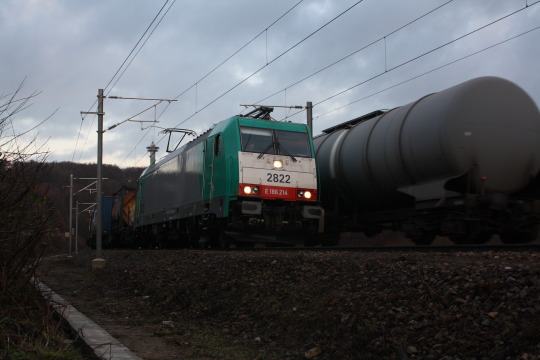
But the business changing is one thing, the story of the PowerHauls seems to be even more complicated. After all, GE did have a launch customer for their PowerHaul, in the form of HHPI. The locomotives were built, painted in HHPI colors, and tested. And then… well, nothing. They never entered service, instead sitting for years in Cottbus, Germany. I have no idea whether they ever got approved for service in Germany. Finnish Wikipedia says "HHPI had no use for them", but that sounds like a euphemism. Clearly HHPI had some use for powerful locomotives, they've recently taken delivery of some Stadler EuroDuals.
The EuroDual and the closely related Euro9000, pictured below, seem to be the solution to the six axle diesel curse though the conceptually simple but technologically difficult trick of simultaneously being a very powerful electric locomotive as well. They have already delivered more of them than Voith Maxima, GE Blue Tiger and GE PowerHaul combined. Sorry for the pictures, they don't park the locomotives well for good photos at Innotrans.
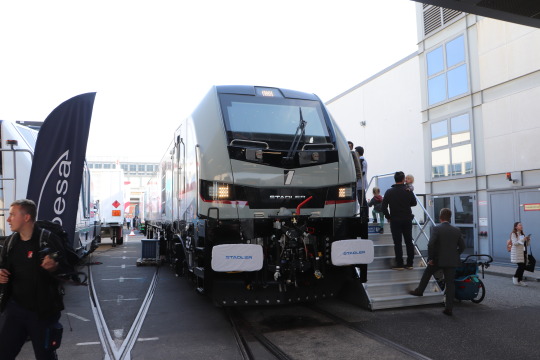

Also, GE was not able to find any customer in Germany, nor in Sweden, where some units of that type were tested at some point. Locomotives of that type were built for Turkey, though, and I haven't heard anything negative about them there. Those were also at Innotrans, in 2014.
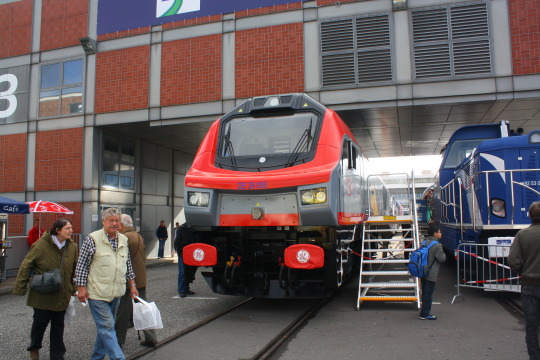
And then, years after everyone had forgotten about these machines, they suddenly turned up in Finland, in the hands of North Rail (formerly Operail), one of the few private companies there. That required at least new couplings, new axles (Finland has a different rail gauge, the measurement of how far the rails are apart), probably adjustments to the breaks, new train control systems and so on.
It's possible that North Rail was thoroughly convinced by the advantages of GE's concept or something, but I think it's far more likely that they just got a really good deal because GE was happy someone took them off their hands.
The reason they're in Finland is almost certainly that Operail needed some cheap machines that weren't doing anything, and these units were just that. But why were they not doing anything? Why were these machines doomed to sit in Cottbus for years, essentially still in new condition, painted for an operator that didn't want them? I'm sure you'll find plenty of theories if you look on online forums, and it's even possible that one of them is the truth, but unless some rail journalist decides to really dig into that, we'll probably never know for certain.
If you allow me to speculate: It certainly doesn't sound like a success story, and there have been all sorts of other stories where trains didn't get approval to run in the country they were ordered for, or had severe technical defects. Ask an Austrian rail fan about the Talent 3, a danish about the IC 4 or a dutch or Belgian about the Fyra to get some really fun rants. I don't know if these locomotives belong in that hall of shame, but it would certainly be an explanation.
My guess is that there won't be any more of these machines ever. GE Transportation doesn't even exist anymore, the whole part of the business got sold to Wabtec a few years ago. But if these machines are doing well in Finland now, good for them! Finally someone found something to do with these weird-looking units.
16 notes
·
View notes
Text
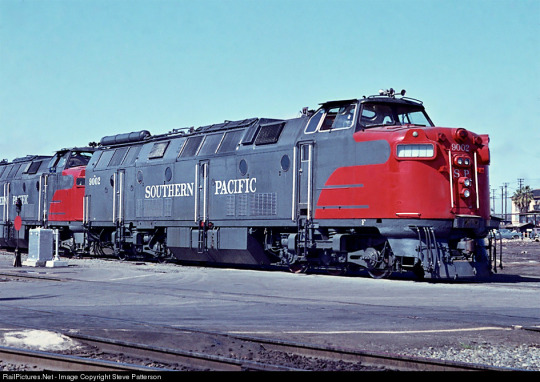
If you aren't sending me Krauss-Maffei ML 4000 pics then what are you sending me...
2 notes
·
View notes
Video
Merzig Saarland Germany 29th April 2018 por loose_grip_99 Por Flickr: Deutsche Reichsbahn (DR) Class 03 Pacific 1010 arrives at Merzig station in the rain with the 11.38 from Saarbrucken during the Rhineland-Palatinate Dampf Spektakel. We took this train back to Trier. The first 03.10 was built in 1939 and 140 were planned but as a result of WWII and the switching of production to 'war essential' goods, only 60 engines were completed by 1941. They were built as streamliners mainly by Borsig, Krupp and Krauss-Maffei but post-war the streamlined bodywork was subsequently removed. Both DB and DR Class 01-10s were rebuilt in the 1950s & 60s. Between November 1965 and September 1966, all DB Class 03.10s were withdrawn, retired and scrapped while the DR engines, including 03-1010, were withdrawn by 1980.
11 notes
·
View notes
Text

Nach einem Partisanenanschlag im Bahnhof Snamenka im Oktober 1943 (vgl. Bild-Nrn. 27712, 27713) wurde 52 6176 vom Bw Bobrinskaja ("Bobr") zur Reparatur ins Lokomotivwerk Krauss-Maffei nach München überführt. Trotz der erheblichen Schäden wurde die Lok wieder aufgearbeitet und ging anschließend Richtung Rumänien, wo sie ab 1944 offiziell bei der CFR in den Büchern geführt wurde. 1945 wurde sie in Ungarn aufgefunden und in die Sowjetunion abgefahren, wo sie angeblich erst 1984 als SZD 1042.453-9 ausgemustert wurde. (05.1944) Foto: Werkfoto (Krauss-Maffei)
Quelle: eisenbahnstiftung.de
4 notes
·
View notes
Text
General Dynamics Land Systems Competitors: A Competitive Landscape in Defense and Combat Vehicles
General Dynamics Land Systems (GDLS) is a major player in the global defense industry, renowned for its design and manufacture of combat vehicles, including the iconic M1 Abrams tank. As a key segment of General Dynamics Corporation, GDLS operates in a competitive environment with several formidable rivals specializing in defense technology, combat systems, and vehicle production.
Here’s an analysis of the key competitors challenging GDLS in the global defense market.
1. BAE Systems
Headquarters: Farnborough, United Kingdom
BAE Systems is a leading defense contractor and one of GDLS’s top competitors. It specializes in producing armored vehicles, artillery systems, and military support vehicles. Notable offerings include the CV90 infantry fighting vehicle and the M109 self-propelled howitzer.
BAE Systems distinguishes itself with a strong focus on innovation and modularity, enabling customization for various military needs. The company's global reach and partnerships with governments worldwide have solidified its position as a direct rival to GDLS in the armored vehicle market.
2. Rheinmetall Defence
Headquarters: Düsseldorf, Germany
Rheinmetall is a prominent European defense contractor with expertise in military vehicles and weapon systems. Its flagship products, such as the Lynx infantry fighting vehicle and the Leopard tank (produced in partnership with Krauss-Maffei Wegmann), make it a significant competitor to GDLS.
Rheinmetall's strong engineering capabilities and focus on advanced technologies, such as active protection systems and autonomous vehicle solutions, position it as a formidable rival in the combat vehicle segment.
3. Oshkosh Defense
Headquarters: Oshkosh, Wisconsin, USA
Oshkosh Defense specializes in tactical wheeled vehicles for military applications, including the Joint Light Tactical Vehicle (JLTV), which is a direct competitor to GDLS’s lighter combat vehicle offerings.
Oshkosh is known for its durability-focused designs and proprietary technologies like TAK-4® independent suspension systems. Its expertise in lightweight and highly mobile platforms gives it an edge in areas where agility and speed are critical.
4. Krauss-Maffei Wegmann (KMW)
Headquarters: Munich, Germany
KMW, often working in collaboration with Rheinmetall, is a leader in producing heavy military vehicles such as tanks and self-propelled artillery. The Leopard 2 tank, one of the most advanced main battle tanks globally, competes directly with GDLS’s M1 Abrams.
KMW's focus on integrating cutting-edge technologies, including advanced optics and fire-control systems, makes it a preferred supplier for many European nations.
5. Lockheed Martin
Headquarters: Bethesda, Maryland, USA
Although primarily known for its aerospace capabilities, Lockheed Martin competes with GDLS in specific land systems through programs like its modernized ground combat vehicles and unmanned ground systems.
Lockheed Martin leverages its expertise in integrated systems and defense electronics to provide versatile land platforms. Its ability to integrate advanced sensors and AI technologies into combat vehicles positions it as a competitor in areas where GDLS is also innovating.
6. Leonardo S.p.A.
Headquarters: Rome, Italy
Leonardo is a global defense company offering a range of land vehicles, including armored personnel carriers and infantry fighting vehicles. Its Freccia and Centauro vehicles are widely used in Europe and other regions, competing with GDLS’s mid-range combat platforms.
Leonardo's focus on collaboration and its ability to provide end-to-end solutions, including weapon systems and electronic warfare technologies, make it a noteworthy competitor in the land systems market.
7. Hyundai Rotem
Headquarters: Seoul, South Korea
Hyundai Rotem is a growing competitor in the armored vehicle market, particularly in Asia. Its K2 Black Panther main battle tank is a rival to GDLS’s M1 Abrams and has garnered attention for its advanced mobility and protection features.
Hyundai Rotem’s focus on innovation and its growing exports to global markets make it a rising competitor to watch in the combat vehicle sector.
Conclusion
The competitive landscape for General Dynamics Land Systems is marked by the presence of well-established global players with distinct strengths. While GDLS remains a leader with its proven platforms like the M1 Abrams and Stryker vehicles, rivals such as BAE Systems, Rheinmetall, and Oshkosh Defense continue to challenge its dominance through innovation, regional influence, and tailored offerings.
As the defense industry evolves, GDLS must continue to focus on technological advancements, strategic partnerships, and cost-effective solutions to maintain its competitive edge in the global market.
0 notes
Text
Γερμανικά Leopard 2HEL: Το διαιτητικό δικαστήριο επιδίκασε αποζημίωση 23.000 000 ευρώ στην KNDS Deutschland για καθυστερημένες πληρωμές στη σύμβαση 016A/2003
«Γλυκιά ήττα» για την ελληνική πλευρά αποτελεί η πρόσφατη απόφαση του διαιτητικού δικαστηρίου του Διεθνούς Εμπορικού Επιμελητηρίου (ICC: International Chamber of Commerce), η οποία επιδίκασε αποζημίωση περίπου 23.000.000 ευρώ στη γερμανική εταιρία KNDS Deutschland (πρώην Krauss-Maffei Wegmann – KMW) για καθυστερημένες πληρωμές στη σύμβαση 016A/2003 για την προμήθεια των 170 αρμάτων μάχης Leopard…
0 notes
Text
Γερμανικά Leopard 2HEL: Το διαιτητικό δικαστήριο επιδίκασε αποζημίωση 23.000 000 ευρώ στην KNDS Deutschland για καθυστερημένες πληρωμές στη σύμβαση 016A/2003
«Γλυκιά ήττα» για την ελληνική πλευρά αποτελεί η πρόσφατη απόφαση του διαιτητικού δικαστηρίου του Διεθνούς Εμπορικού Επιμελητηρίου (ICC: International Chamber of Commerce), η οποία επιδίκασε αποζημίωση περίπου 23.000.000 ευρώ στη γερμανική εταιρία KNDS Deutschland (πρώην Krauss-Maffei Wegmann – KMW) για καθυστερημένες πληρωμές στη σύμβαση 016A/2003 για την προμήθεια των 170 αρμάτων μάχης Leopard…
0 notes
Text

It's a Leopard 1A5 turret on PUMA prototype hull (PT2). The PUMA (not be confused with the current German IFV Puma) was a private joint development of Krauss-Maffei and Diehl in the late 80s, aimed at creating a family of light to medium tracked vehicles. The whole project never took really off despite initial interest from several Armies, mostly due to budget cuts and the incoming wave of surplus equipment.
7 notes
·
View notes
Note
Hello tank man. Me and my cousins found this dude at grans, we think it’s an Abrams, but our tank knowledge is limited.


Leopard 2a4, West German MBT, 1985, Krauss Maffei
The 2a4 is notable for being the last variant of the Leopard 2 manufactured before reunification, as well as for being the last model not to feature sloped turret armor
99% confidence
10 notes
·
View notes
